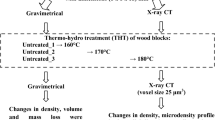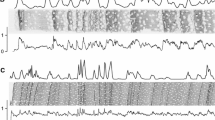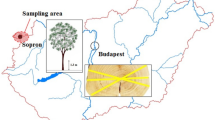Abstract
Matrix uniqueness in different wood species was analysed using X-ray spectrometry in order to specify, whether separate calibration for particular species is required. Results of XRF measurements of three deciduous species specimens were compared: oak (Quercus robur L.), beech (Fagus sylvatica L.) and birch (Betula pendula). Three forms of specimens were examined: solid wood, powdered wood and pelletized powdered wood. Results show that each species is definitely a different matrix, as well as each form of a sample. It means that different calibration is needed for each species in order to perform quantitative analysis. Comparison of results of the same species samples should be performed for samples of the same form.
Zusammenfassung
Um zu bestimmen, ob eine getrennte Kalibrierung bestimmter Holzarten notwendig ist, wurde mit einem Röntgenspektrometer untersucht, wie diese als Matrix die Ergebnisse beeinflusst. Die Ergebnisse der Röntgenfluoreszenzmessung der drei Laubholzarten Eiche (Quercus robur L.), Buche (Fagus sylvatica L.) und Birke (Betula pendula) wurden verglichen und zugleich jeweils in den drei Probenformen Massivholz, Holzmehl und Holzpellets untersucht. Die Ergebnisse zeigen, dass jede Holzart sowie jede Probenform eine unterschiedliche Matrix darstellt. Dies bedeutet, dass für eine quantitative Analyse eine getrennte Kalibrierung für jede Holzart notwendig ist. Für den Vergleich innerhalb einer Holzart sollte jeweils die gleiche Probenform verwendet werden.
Similar content being viewed by others
1 Introduction
X-ray spectrometry may be very useful to analyse mineral substances content in wood. It is a quite fast and non-destructive technique and has often been used for preserved wood examination. Vives et al. (2005) applied this technique for CCA treated eucalyptus and pine wood analysis (distribution of Cu, Cr and As). Zawadzki et al. (2010) used XRF to analyse the penetration of ACQ preservative into the pine wood sample structure. These are only two examples from many.
Although XRF seems to be a good tool for other aspects of wood elemental analysis, not many references can be found. For example, dendrochemical analysis which is often made in order to specify the influence of environmental pollution on wood chemical composition (mainly metal content) is usually performed with other instrumental techniques such as AAS (Patrick and Farmer 2006) and ICP-MS (Watmough 2001). The reason for this fact can be found in other papers concerning analysis of preserved wood; XRF in wood examination is very useful, but only qualitative analysis is possible without additional often complicated procedures. It is because this kind of spectrometer is calibrated using metal or soil standards not compatible with complicated, anisotropic wooden matrix. Although thin-film standards are often applied to calibrate the system (Vives et al. 2005), it seems to be not sufficient. Baernthaler et al. (2006) presented their complex analyses of metal content in solid biofuels, including wood. Direct XRF measurements of wood gave different results in relation to other methods which have been acknowledged as reliable. Block et al. (2007) performed parallel measurements using atomic absorption with flame atomization to compare XRF results. They were significantly different. The authors suggested using such a comparison to calculate conversion equations which could provide higher quantitative accuracy. It became obvious that the wood matrix is very specific and needs separate calibration to perform quantitative analysis. Moreover, it is very probable that the matrix differs significantly between particular wood species.
The aim of this work is to confirm or deny this last thesis.
2 Materials and methods
To realise the assigned task, specimens of three deciduous species were prepared: oak (Quercus robur L.), beech (Fagus sylvatica L.) and birch (Betula pendula). Material was obtained from Mazovian-Podlasie region.
Ten wood blocks from each species were cut with dimensions of 30 × 15 × 15 mm³. One surface (15 × 30 mm²) parallel to the grain from each sample was measured using point scan and mapping option of XRF spectrometer. Collimator with screen 2 × 2 mm2 was used. Ten points on each sample were assigned to measurement with point scan option. Mapping resolution was 22 × 8 for oak and birch, 23 × 9 for beech. Then, the scanned surface was powdered with abrasive paper, and the powdered wood after leveling was also analysed by the two options. After this, the powdered wood was pelletized in a laboratory press with a pressure of 7.5 mpa for 5 min, and pellets were measured using the two options. Each powder and pellet sample was measured five times with point scan option. Mapping resolution differed. Exposure time of each point was 300 s for point scan and 30 s for mapping.
Impulse count values for different elements were the results of these analyses. Values for each sample were averaged and compared. Manganese, copper, iron and lead were chosen for comparison. Manganese is the heavy metal with the highest content in wood, copper is the element present in many wood preservatives, iron remains in wood after tool working, and lead is the important indicator of environmental pollution, so these elements are of practical meaning in the examination of wood chemical composition.
All measurements were performed using XRF Spectro Midex M spectrometer.
3 Results and discussion
It was assumed that different matrixes will result in different relations between average values of impulse counts for the three sample forms. It is because powdering and pressing should cause other changes in the structure of particular matrixes. That is why the results were presented in a form allowing for comparison of above mentioned relations.
Figure 1 presents the results obtained for copper. Numbers on the columns mean standard deviation from average value. There are almost no observable differences in mapping results. Point scan analyses show that relations between values obtained for wood blocks, powder and pellets are different: the highest value in birch samples was reported for pellets, while values for other sample forms are similar; values for pellets and blocks in beech wood are almost the same and much lower than for powder; in oak wood values of impulse counts decrease in the sequence pellets-powder-blocks and the last value is much lower than the others.
It must be emphasized that calculated standard deviations are much higher for samples examined with point scan option (even up to 61 %), but the highest standard deviation values were obtained for the lowest results of average impulse counts. However, this does not significantly change the relations resulting from the graph. Higher standard deviations for point scan option occur for two reasons. First, number of exposed points in mapping option is much higher. Second, time of exposure is ten times longer for point scan option and with increasing exposure time distinctions for different points become more significant. This phenomenon can be perfectly seen in Figs. 1 and 2, where analogical results obtained for iron are presented.
Relations between the three sample forms for particular species are similar both for mapping and point scan options which is exceptional compared to other elements examined. Participation of block results is much lower for point scan, powder and pellets results relation is similar both for mapping and point scan. In general, repeatability of results between different species (similar values of average impulse counts) seems to be strange, because it is improbable that any element impulse count value is almost the same in all three species. In case of mapping results it can be explained by relative low content of analysed elements and short time of exposure which does not lead to different exposition. As mentioned above, such an effect should not appear for point scan option. High standard deviations may be one possible explanation and the repeatability of point scan results is just accidental, in fact averages may differ significantly. This phenomenon may also be explained by the contamination of wood surface with iron from the saw which was used to cut the specimens. Wood surfaces of all three species were contaminated to a similar degree which is much higher than initial iron content in wood. Third, it must not be forgotten that even small differences in impulse count value might mean quite significant differences in element content.
Figure 3 shows relations between manganese impulse counts values. They are similar in case of mapping, but their analogy is not as clear as in the previously discussed elements. Relations between analysed values for point scan are different for particular species, especially the participation of impulse count values from solid wood surface measurements. Relations obtained for lead could be described in the same way (Fig. 4), but in this case the results for pellets differ most.
4 Conclusion
The mapping method gives results with lower standard deviations due to much higher number of exposed points than in point scan method. In addition, the shorter time of each point exposure is very important (differences in impulse count increase with exposure time). That is why the relations between the results of the three sample forms differ significantly for particular species, almost only for point scan method. However, some differences are observable for the mapping option, especially in lead and manganese results.
Another interesting fact arising from the presented results is that there are often differences in dependences of impulse counts value on the exposure time in particular sample forms. For example, the participation of copper impulse counts value for oak wood is the highest for the mapping option and the lowest for point scan.
Above mentioned observations confirm that each species is a unique matrix for XRF measurements. The same procedure performed on all species specimens gives other changes in impulse count values. Moreover, each form of the sample (block, powder, pellet) is another matrix too—content of examined elements does not change, but the value of impulse counts does.
The results here show that application of any universal standard for wood quantitative analysis with the XRF technique apart from wood species is unjustified. Results obtained by application of such a standard will most likely be incorrect.
References
Baernthaler G, Zischka M, Haraldsson C, Obernberger I (2006) Determination of major and minor ash-forming elements in solid biomass fuels. Biomass Bioenergy 30:983–997
Block CN, Shibata T, Solo-Gabriele HM, Townsend T (2007) Use of handheld X-ray fluorescence spectrometry units for identification of arsenic in treated wood. Environ Pollut 148:627–633
Patrick GJ, Farmer JG (2006) A stable lead isotopic investigation of the use of sycamore tree rings as a historical biomonitor of environmental lead contamination. Sci Total Environ 362:278–291
Vives AES, Silva RMC, Medeiros J. G. da S, Tomazello Filho M, Barroso RC, Zucchi OLAD, Moreira S (2005) Accumulation of elements in annual tree rings measured by synchrotron x-ray fluorescence analysis. X-Ray Spectrom 34: 411–416
Watmough SA (2001) A dendrochemical survey of sugar maple (Acer saccharum march) in south-central Ontario, Canada. Water Air Soil Pollut 136:165–187
Zawadzki J, Zielenkiewicz T, Radomski A, Witomski P, Drożdżek M (2010) Testing content of copper in scots pine wood (Pinus sylvestris L.) after preservative treatment. Wood Res 55(4):91–100
Open Access
This article is distributed under the terms of the Creative Commons Attribution License which permits any use, distribution, and reproduction in any medium, provided the original author(s) and the source are credited.
Author information
Authors and Affiliations
Corresponding author
Rights and permissions
Open Access This article is distributed under the terms of the Creative Commons Attribution 2.0 International License (https://creativecommons.org/licenses/by/2.0), which permits unrestricted use, distribution, and reproduction in any medium, provided the original work is properly cited.
About this article
Cite this article
Zielenkiewicz, T., Radomski, A. & Zawadzki, J. XRF examination of matrix uniqueness in chosen deciduous wood species. Eur. J. Wood Prod. 70, 845–849 (2012). https://doi.org/10.1007/s00107-012-0636-5
Received:
Published:
Issue Date:
DOI: https://doi.org/10.1007/s00107-012-0636-5








